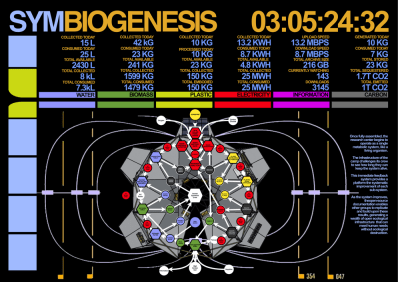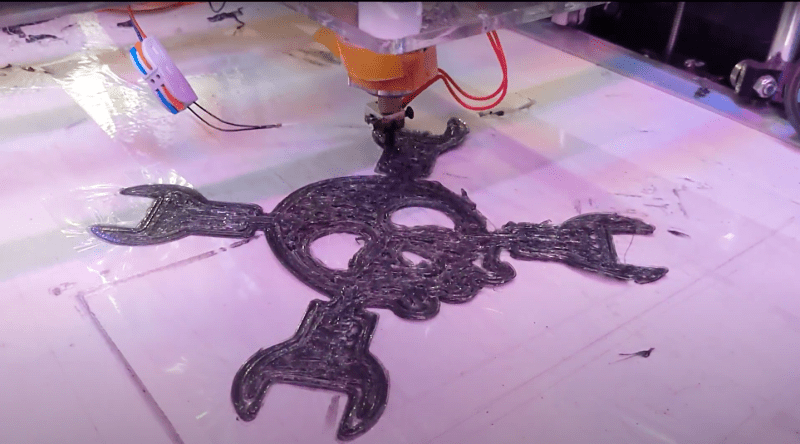Do you remember [Sam Smith]’s Metabolizer from a few years back? In case you’ve forgotten, this baby takes trash and turns it into printed plastic objects, and it’s solar-powered to boot. Although the Metabolizer didn’t win the 2018 Hackaday Prize, [Sam] and his machine won many achievements that year, including the Open Hardware Challenge. It’s fantastic to see the project still improving.
 To recap, the sun hits the solar panels and charge up the battery bank. Once there’s enough power to start the reaction, it gets dumped into a heating element that turns biomass into biochar. This smoke is cooled, collected, refined, and fed into a small gas generator, which produces DC power to run a 3/4-horsepower shredder and the trash printer.
To recap, the sun hits the solar panels and charge up the battery bank. Once there’s enough power to start the reaction, it gets dumped into a heating element that turns biomass into biochar. This smoke is cooled, collected, refined, and fed into a small gas generator, which produces DC power to run a 3/4-horsepower shredder and the trash printer.
[Sam] likens this beast to a Rube Goldberg machine in that it performs an overly-complicated chain reaction to do a simple task. We certainly see his point, but we think that this machine is worth so much more than those classic machines, which tend to do nothing useful at all and tend to consume many resources in the process. On the contrary, the Metabolizer’s chain reaction starts with sunshine and ends with useful objects that keep plastic out of landfills. Honestly, it’s more akin to a compost heap with a PhD in Biology and a handful of steroids and a 3D printer attached.
Unfortunately, [Sam] couldn’t get a prototype working in time for the Prize, and he turned to Patreon to gain support after the $1,000 ran out. Three years and a ton of improvements later, [Sam] has a working prototype that’s cheaper, more efficient, and easier to build. But can it be built relatively easily by someone other than [Sam]? Consider the gauntlet thrown down.
Not happy with your standard-style compost pile? You need a DIY trommel to sift out the bad stuff.















Interesting. I wonder how the efficiency of converting the paper/cardboard input to liquid fuel to generate electricity compares with just burning it instead (and generating electricity using a steam turbine)? It looks like it is running outside, which is probably a good idea given the fumes that might be coming off of it.
Neat to read! Way to go! I literally just checked the tracking on some Silicon Carbide (80grit) I recently ordered to coat a hot finger (cold finger in reverse… ok not exactly though heat flow) using silica glass to adhere, that will be at the focal point of the Fresnel Lens that I’m amazed I’ve not seen anyone make a design using a waveguide like Horn Antenna to improve heat transfer.
I also think the Horn Antenna will make the unit safer so kiddos can see the system used and the “oven” focal point being somewhat akin to an old wood burning stove hot plate with potential to place a pot down in the oven like the Tamera solar cooker/oven design focal point area/volume.
I also plan to use some sort of either bio-refractory fiber or kao like wool to line the fixed position heater box oven focal point area. Planning to also eventually automate tracking and have more materials to work on that. Planning to just have the pivot point being the axis where the focal point is for now, where I’ll have to counter weight behind the stove box.
I’m also wondering about needing an air curtain just behind the lens in the future for hot days and also planning a flock material or at least for now the white on one side and black on other grow room material I have for the front drop curtain to control temp and power on/off.
Wondering if the above might inspire another method to go about the initial powering of the system?
Another odd observation I’ve not read about online is no one is using the mirrors from the old projection screen TV’s. I’ve stashed a few of those too, with plans to make an optical train for lower light conditions periods… plus a possible solar oven.
must be great to smell it :)
Just to have a machine that could turn plastic waste into bricks, lego bricks, tiles, etc. may be a neat machine to have.
No one is going to comment on the neat LCARS?